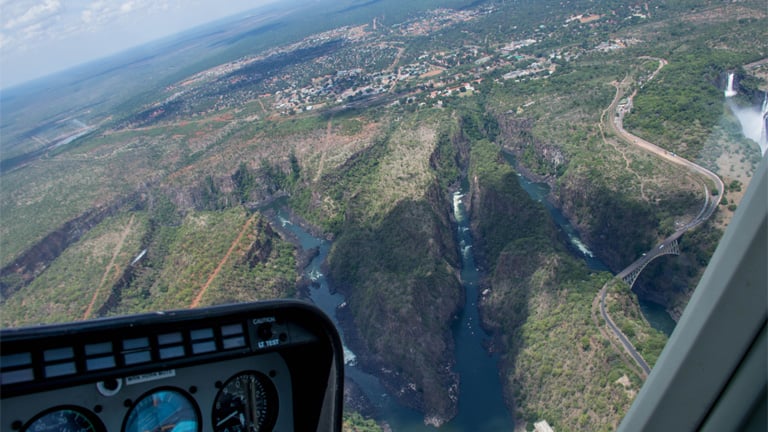We sat down for a chat with Paul Oldroyd and Glenn Isbell of Bell Helicopter. They offer some wonderful advice during our conversation. We talked everything from air taxi innovations to solid career advice, and more. We can’t thank them enough for taking the time out of their busy schedules to offer their knowledge and expertise.
Bell Helicopter is practically becoming synonymous with civilian air taxi travel. While we’re all excited about these developments, there are obviously a few steps between where we stand now and full implementation. In your professional opinion, what might that process look like?
This challenge is bigger than any single entity. Success can only be realized in a truly collaborative environment…
Can you give us insight as to the changes that may need to take place in urban infrastructure in order to fully implement air taxi travel?
There are several. I believe any list of significant changes must include the following.
Airspace deconfliction and associated regulations are one of the biggest barriers. Variables to be considered include autonomous vs. human pilot, product delivery vs. human transport, and VTOL vs. fixed-wing aircraft. All compete in the same low-altitude airspace. Any solution will require a fully integrated suite of sensor arrays and stations, concentrated in but not limited to high population density markets. Establishing policy and regulatory guidelines, monitoring, enforcement, homeland security, environmental and noise issues are all challenging. This is a decades long development.
The Air / Ground transportation interface is a major barrier. Vertiports are necessary, but just allocating space is not enough. As an example, there are over 70 heliports in San Francisco. Most are never used due to safety concerns. Only a few of them are even approved for use by the FAA and those under special conditions or circumstances. Ground transportation ingress/egress, parking, TSA and site security are all issues that can become choke-points. Even building codes for vertiports will need to be universalized and regulated… currently, they are managed locally at best. Lastly, financial issues will need to be addressed, including agreement in the political landscape… Federal vs. regional vs. State and local, international borders, zoning, easement, environmental concerns, tribal lands, etc. This too is a decades long challenge.
Aircraft Certification – In spite of recent product developmental aircraft demonstrations and introductions, current air-vehicle concepts are still immature and performance limited. Flight control systems and sensing are becoming exponentially more sophisticated, but they are still insufficient to provide vehicle omniscience, or even to ensure safe operation in a high population density urban environment. There is also a tremendous amount of work that needs to be accomplished to establish a certification basis for EVTOL aircraft. Multiple efforts are in progress with the major global certification agencies, but this is a long process as well.
Air Vehicle Manufacturing. The last issue worth consideration is a financial commitment by industry that will be necessary to achieve low-rate initial production, and eventual high-volume production manufacturing at large economies of scale. Although there is a promise of high-volume production, the realization will require substantial investment akin to the magnitude of the investment by ground transportation industries. The cost of the vehicle must become affordable. To achieve that, manufacturers will need to carefully exploit IIoT and digital, automation, rapid processing, lower-cost composites, and flexible cellular manufacturing. They will need a truly “Flexible Smart Factory” (FSF). Individual detail and sub-assembly elements must approach self-awareness or at least be more self-diagnosing, self-repairing, stand-alone, replicable. The assemblage of such in an FSF can adjust for dynamic changes such as raw material interruptions, surge requirements, defect ID and quarantine, spares production, customization, offset, and mobile factory components.
Considering these barriers, the catalyst for rapid insertion will likely come from private industry – first demonstrated with air-logistics, followed by air-taxi. Offshore, private, luxury, and sport will also affect the curve. I believe the fastest path to air-taxi deployment will be funded by private investment on specific point-to-point routes in highly congested commuter environments.
Follow up question: What will the cost of this travel look like initially? How long until this becomes accessible to the middle-class masses?
Initially, cost/seat mile will be high, and air-taxi will be novelty for a while. Revenue projections air-taxi is currently being debated by every potential provider, Bell included. The innovations of the next few years will begin to define the cost equation. This explosive level of competition should drive the cost curve at a faster rate than the evolution of airline travel costs in the 50’s and 60’s, but it will take time.
2019 was a great year for Bell. What’s ahead for 2020 and beyond?
In the VTOL space, it is always a challenge to balance commercial vs. military investment. Both business models are different. Bell was recently awarded contracts to design and build demonstrator aircraft under both the Future Aerial Reconnaissance Aircraft (FARA) and the Future Long Range Attack Aircraft (FLRAA) programs. These are great wins. Military business will demonstrate air vehicle performance, provide the technical catalyst and provide investment capital necessary to accelerate development of both air-logistics and air-taxi platforms.
We want to thank Bell for consistently being a very active partner with SME, participating in multiple events each year. Why do you feel these events are so important to the industry?
This is a great venue for networking. SME is particularly good at providing a collaborative environment where industry, academia, government, and regulatory agents can work together…
Thanks to SME for providing this valuable opportunity.
